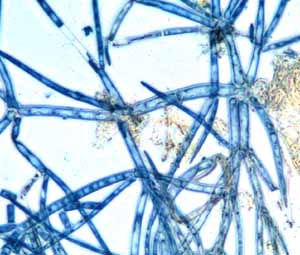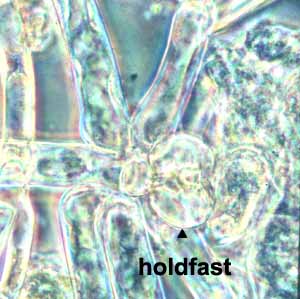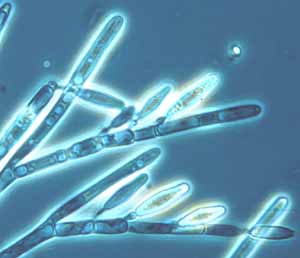|
There is limited information about fungal/animal
symbiosis in most mycology textbooks. One of the compelling reasons that
animals need a symbiotic relationship with fungi is that animals cannot
digest cellulose. Hey, horses and cows eat plants and seem to get by! But,
they have bacteria or other organisms in their digestive system that can do
the cellulose digestion.
1.
Trichomycetes:
A commensal
is a companion at meals. In biology, the term commensalism means a close
association or union between two organisms in which one is benefited by the
relationship and the other is neither benefited nor harmed. Some biologists
view this as a form of symbiosis. Trichomycetes
are the most striking example of commensalism among the fungi. They
are associated with living arthropods such as insects, millipedes, and
crustaceans, growing extensively in the hind gut (Fig. 14-81).
Most all species grow internally within the hindgut of their host where they
attach to the chitinous lining by means of a holdfast (Fig. 14-82).

Fig. 14-81. Highly branched filaments of Asellaria
ligiae.

Fig. 14-82.
The foot cell (or holdfast) of Asellaria ligiae.
The holdfast may be looked upon as somewhat a
“sucker disc” that attaches the filamentous fungi to the hindgut.
The mycelium apparently absorbs its nutrients from the contents of the
hindgut. Dr. Robert W. Lictwardt of the University of Kansas is
the world authority of this group of fungi. He and his colleagues have
described a number or orders of Trichomycetes based upon the septation
and branching of the filaments and on the types of spores they produce.
Asexual reproduction may be by amoeboid cells, sporangiospores, or
spores produced on a threadlike trichome (Fig. 14-83).
CLICK HERE TO GO TO TOP OF
RIGHT SIDE COLUMN
|

Fig. 14-83. Filaments of Smittium
culicis showing attached trichospores.
That is why the spores are called trichospores
and why this group of fungi is called the Trichomycetes. It has been
suggested that the trichospores are instrumental in dissemination of the
fungus, especially since insects molt and shed their exoskeleton and
hind gut. Sexual reproduction has been found only in a few species of
Trichomycetes such as species of Harpella
where biconic spores, believed to by zygospores, are formed on the
filaments.
Some of the Trichomycetes, such as species of Smittium
that occur on mosquitoes, have received considerable attention. High
populations of Smittium on mosquitoes have been shown to have a negative impact on
mosquito colonies and thus might serve as a type of biological control.
For those who want to learn more about this fascinating group of fungi
they can refer to Lichwardt’s book (The Trichomycetes, Fungal
Associates of Arthropods, Springer).
2.
Ambrosia Fungi
Many fungi are known to be associated with ambrosia
beetles. Most of them are conidial (asexual) states of
Ascomycetes. Ambrosia means “food of the gods” and is commonly a name given
to a fruit salad with shredded coconut and fruits. Ambrosia beetles are
those beetles that produce piles of shredded wood and debris outside their
galleries. There are several fungi that grow within this debris, the ambrosia fungi, and have been shown to have a mutualistic
relationship with ambrosia beetles. The bark beetle that is currently
devastating populations of southern yellow pines is one of the ambrosia
beetles. Batra (1979.
Insect-Fungus Symbiosis. John Wiley & Sons, N.Y.276 pp.) list the
following examples of ambrosia fungi: Absidia,
Ambrosiella, Aspergillus, Cephalosporium, Ceratocystis, Chaetomium,
Endomyces, Endomycopsis, Fusarium, Monilia, Penicillium, and Tuberculariella.
It has been shown that certain ambrosia fungi are
required for reproduction of the beetle (French & Roper, 1972. Can.
Entomol. 104:1635-1641, 1972). They influence the hatching of eggs,
provide food for the developing larvae, and prevent the encroachment of
pathogenic fungi. The insect
in turn provides plant debris and insect excrement as a food source for
the fungi, and eventually is instrumental in disseminating the fungus.
Many of these beetles have specialized compartments within their digestive
system called mycangia.
which hold fungal spores for later excretion whenever the insect arrives
at a new site.
For
illustrations of ambrosia fungi see File III, B,1.
|